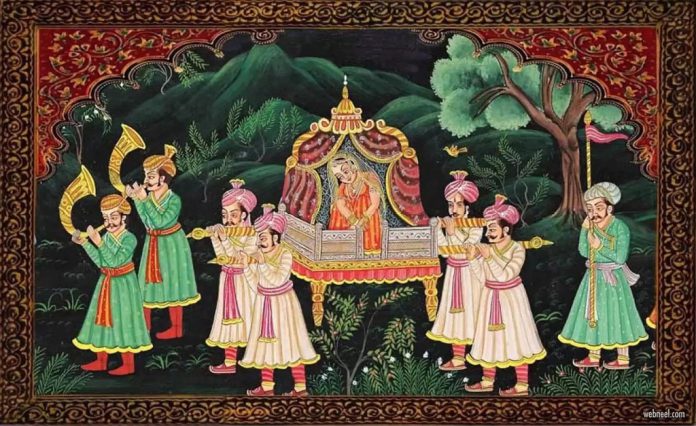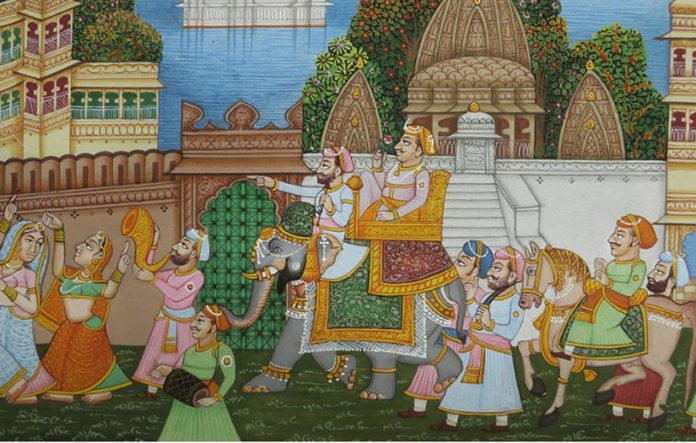THE HISTORY OF THE BHATIS
Bhatis are members of a Rajput clan that originated in central India. The Bhatis is said to have reportedly originated in Mathura through a common ancestor named Bhati, who was a descendant of Pradyumn. In Hindu mythology, Pradyumna (Sanskrit: प्रद्युम्न) is touted as being the eldest son of the Hindu deities Krishna and his chief consort, Rukmini.
According to the seventeenth-century Nainsi ri Khyat, the Bhatis after losing Mathura moved to Bhatner in Lakhi Jungle, and from there to other locations in western and northwestern India. Jaisalmer had a dynasty with a successful line of Bhati rulers and this eventually became their centre. Bhatner, Pugal, Bikrampur, Barsalpur, Deravar, Maroth, Kehror, Aasnikot, Tanot, Ludrovo and Mamanvahan were some of the fortified settlements that were historically ruled by the Bhati clan and subclans. The Bhati ruler Vijayrao was known as the ‘Uttara disi bhad kivaad’ (the sentinel of the north direction), due to his control over forts and settlements that extended from Ghazni to Gujarat, leading to several conflicts with the invading Muslim tribes.
THE HISTORY OF THE PARAMARS
Parmar is a Rajput clan found primarily scattered across Northern and Central India, especially in Rajasthan, Punjab, Haryana, Kutch, Uttarakhand, Uttar Pradesh, Bihar, Madhya Pradesh and North Maharashtra.
The Paramara dynasty was an Indian dynasty that ruled Malwa and surrounding areas in west-central India between the ninth and fourteenth centuries. They belonged to the Parmara clan of the Rajputs.
It is believed that the dynasty was established sometime around the ninth or tenth century. Its early rulers most probably ruled as vassals of the Rashtrakutas of Manyakheta. The earliest Paramara inscriptions, issued by the tenth-century ruler Siyaka, have been found in the western Indian state of Gujarat. Around 972, Siyaka sacked the Rashtrakuta capital Manyakheta, establishing the Paramaras as a sovereign power. By the time of his successor Munja, the Malwa region in present-day Madhya Pradesh had become the core Paramara territory, with Dhara (present-day Dhar) as their capital. The dynasty reached its zenith under Munja’s nephew Bhoja, whose kingdom extended from Chittor in the north to Konkan in the south, covering large swathes of the Indian subcontinent. The Paramara power rose and declined several times as a result of their constant competition with fellow rulers including the Chaulukyas of Gujarat, the Chalukyas of Kalyani, the Kalachuris of Tripuri, Chandelas of Jejakabhukti and other neighbouring kingdoms. The later Paramara rulers moved their capital to Mandapa-Durga (present-day Mandu) after Dhara was sacked multiple times by their enemies, weakening their grip over power. Mahalakadeva, the last known Paramara king, was defeated and killed by the forces of Alauddin Khalji of Delhi in 1305 CE, although epigraphic evidence suggests that the Paramara rule continued for a few years after his death, but eventually ended.
THE HISTORY OF THE CHAVDA
The Chavda dynasty (often referred to as Chawda, Chavada, Chapa, Chaparana, and Chapokata among others) was a Hindu-Rajput clan that ruled over a cluster of regions that now form northern Gujarat, from around 746 to 942.
Chavada Dadda, the founder of the Pratihara dynasty, established the Gurjar rule at Nandipur (Nandol). Dadda III wrested Broach from the Maitraks whose citadel began to weaken. Interestingly, during this period various parts of Gujrat had been ruled over by three competing dynasties: the Gurjars over the north, the Chalukyas over the south and the Maitraks over Saurashtra.
Once a power vacuum came upon to be by the fall of the Maitrak dynasty, it was rapidly filled up by the Pratiharas from the north and Rashtrakutas from the south. Naturally, As vassals of the Valabhis (from the town of Valabhis), the Chavadas held their sway over parts of north Gujarat. And quickly moved in to assume independent control after the fall of Valabhi. Vanraj, the most prominent of the eight Chavada kings, founded a new capital at Anhilpur Patan. he reconquered his father’s lost territories and founded the Chavada dynasty which lasted a little under a century. Samantsinh, the last Chavada ruler, did not have a child of his own and therefore adopted Mulraj, who went on to overthrow him in 942 AD.
Mulraj thereafter set up what came to be known as the Solanki dynasty. Given his ambitious disposition, he quickly started expanding his frontiers, establishing a total hold over Saurashtra and Kachch by defeating Grahripu of Junagadh in Saurashtra and Lakho Fulani of Kachchh.
Mulraj Solanki’s reign marked the start of the most glorious period in the history of Gujarat during which Gujarati culture. It is described as the golden period in Gujarat’s history.
THE HISTORY OF SOLANKI
Solanki, also referred to as Chaulukya, is a clan name originally associated with the Indian Hindu Rajputs in the Northern region of the country. The Chaulukya dynasty was a dynasty that ruled parts of what now form the states of Gujarat and Rajasthan in north-western India, sometime between c. 940 CE and c. 1244 CE. Their capital was located at Anahilavada (modern Patan).
Mularaja Solanki, the founder of the dynasty, routed out the last ruler of the Chavda dynasty around 940 CE, marking the start of the Chaulukya’s rule. His successors fought several battles with the neighbouring rulers such as the Chudasamas, the Paramaras and the Chahamanas of Shakambhari to extend the borders of their nascent dynasty. During the reign of Bhima I, the Ghaznavid ruler Mahmud invaded the kingdom and raided the Somnath temple during 1024-1025 CE. During the ferocious invasion, Bhima had to temporarily leave his capital and take shelter in Kanthkot, but after Mahmud’s departure, he recovered his power and retained control of his ancestral territories.
The kingdom reached its zenith under the rule of Jayasimha Siddharaja and Kumarapala in the 12th century. Several minor dynasties, such as the Chahamanas of Jalor and the Chahamanas of Naddula, served as Chaulukya vassals during this period. After Kumarapala’s death, the kingdom was gradually weakened by internal rebellions. Taking advantage of this, the Vaghelas, who had earlier served as Chaulukya generals, usurped the power and established a new dynasty in the 1240s.





